Contents
There are several ways to tie peas in the garden. Most varieties need a support; you can build it with your own hands from improvised means.
Why do you need support for peas
Peas have weak stems and can only maintain a vertical position without support up to 30 cm. After that, the shoots continue to grow in length up to 3 m, but lie down on the ground under their own weight and under the weight of the pods.
It is impossible to leave the culture in this position for several reasons:
- shoots lying on the ground do not receive enough light and oxygen;
- the stems are intertwined with each other, which makes it difficult to harvest;
- in a horizontal position, shoots and leaves are more often affected by fungal diseases and pests;
- the pods lying on the ground under the cover of green mass overripe, after which the bush ends its vegetation ahead of time and begins to dry out.
If you build comfortable props for peas and carefully tie up the stems, the plant will be able to receive enough sun and air. The ripening of the beans will occur evenly, the fruits will be juicy and sugary.
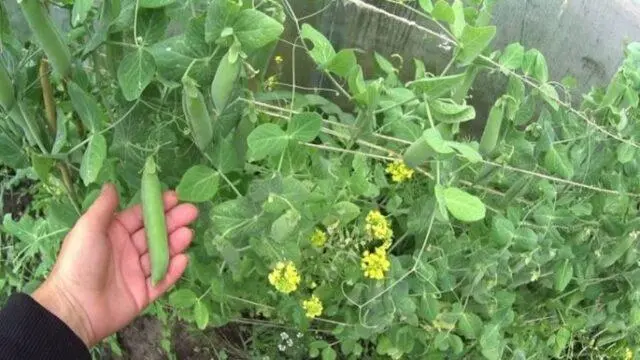
When gartering peas, you need to place the stems at some distance from each other
When to tie peas in the garden
Peas should be tied up in accordance with the real need. They usually focus not on the timing and weather conditions, but on the height of the plants. Peas begin to lie down after they grow to about 30 cm. By this time, they should be fixed on supports, and it is advisable to tie them up even earlier, with a bush height of about 15-20 cm.
How to properly tie peas in the open field
Garter peas in the garden is carried out in many ways. Which one to choose depends on personal preference and convenience. But in the process you need to follow a few rules:
- Most varieties of peas have tendrils designed specifically for clinging to vertical surfaces. For such plants, garter ropes can not be used. If fixation is still necessary for the bush, then a soft cloth that does not injure the shoots should be used as a material.
- When placing pea stalks on supports, gaps of 20-30 cm are left between them. Otherwise, the shoots, even in a vertical position, will intertwine and interfere with each other’s growth.
- For the construction of the support, only healthy and clean wooden stakes and boards without signs of decay or pests are used. Garter infections can spread from trellises to peas, and as a result, the culture will suffer greatly.
- For the installation of supports, it is undesirable to use untreated branches of fast-growing trees. In particular, willow stakes are a poor option. When placed in a garden, they can put down their own roots and turn into young seedlings.
Tall varieties require a garter without fail. But do-it-yourself photos of trellis for peas show that low varieties are also usually fixed. They are less prone to lodging, but under the weight of the pods they still tend to the ground.
Interesting solutions for supports for peas
As supports, you can use ordinary ready-made grids or home-made structures. It is important that the garter structure fits the size of the pea, does not impede harvesting, and does not obscure the plant from the sun’s rays.
Stakes
The simplest version of a support for peas in the garden is stakes driven into the garden at a short distance from each other. As a material, you can use not only the branches of trees and shrubs, but also plastic pipes. Bushes, as they grow, are fixed on supports in several places to support them in an upright position.
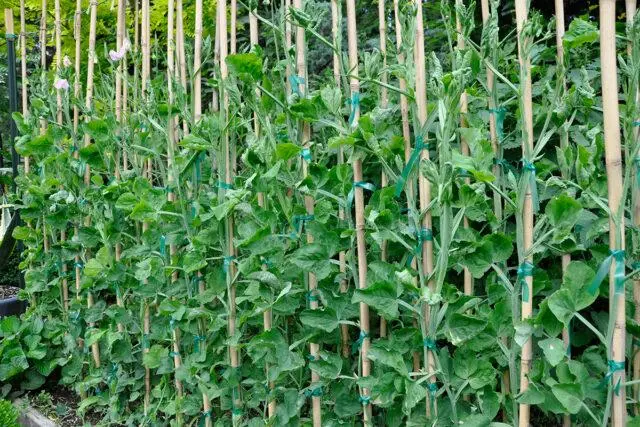
The height of the stakes is selected in accordance with the maximum length of the pea stalks
Сетка
A convenient option for garter peas is a ready-made mesh. It is usually used in conjunction with trellises or stakes – they stretch the material on supports and fix the stems in the cells.
Garter nets are made of materials that do not rot, so they perform their functions for many years. Cell sizes can be different – options with nests of 45, 150, 170 mm are popular. Some nets are designed to withstand low temperatures and can be left in the garden throughout the winter, while others need to be stored away at the end of the season.
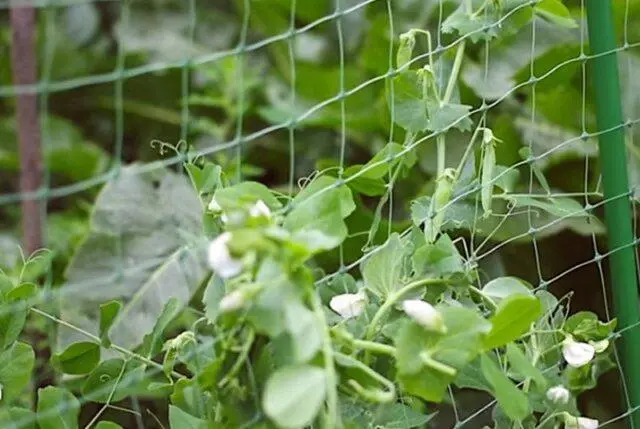
For garter peas, you can use the same nets as for cucumbers, beans and other plants.
Trellis
A trellis is the most common type of pea garter support. The design consists of two poles driven into the ground at the ends of a legume bed, and a mesh or wire stretched between them.
Photos of trellis for peas in the open field show that supports for tall varieties should rise at least 2 m above the ground, and for undersized varieties – 1,5 m. When stretching between wire posts or strong cords, gaps of about 15 cm are left between levels.
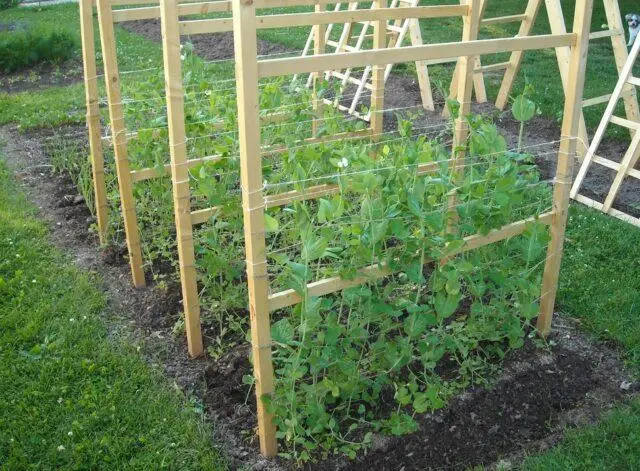
When tied on a trellis, peas receive sunlight and air in full
Hut
As a support for peas in the beds, you can build several “huts”. Long wooden poles are dug into the ground at an angle opposite each other and fastened at the tops. For reliability, longitudinal strips can be installed on the sides of the “hut”. For growing stalks of peas, a garter is carried out to inclined vertical poles in several places from 30 cm above the ground to the very top.
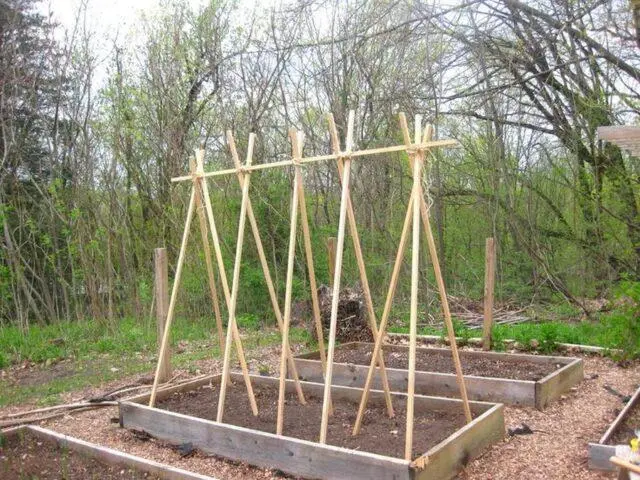
The disadvantages of the “hut” design include poor stability in strong winds
Wigwam
The support for the garter “tepee” is similar in design to the “hut”, but it is a little more complicated. For its construction, they take 5-7 poles of the same length and dig them into the ground at an angle in a circle, and then fasten the tops. When using the structure, growing peas climb up the sticks, and over time, the “wigwam” turns into a green cone.
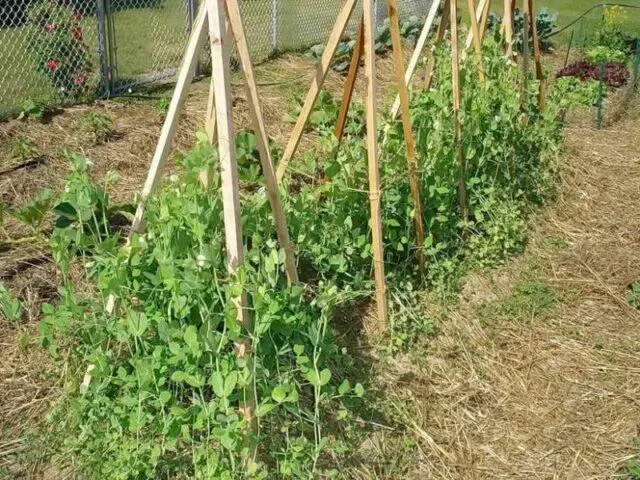
The wigwam support is installed in the garden before sowing peas, since the seeds need to be laid around at the base
bicycle rim
A support using metal rims from a bicycle is also built before sowing pea seeds. The schema looks like this:
- One of the circles is laid on the bed.
- A wooden plank or an iron rod 1,5-2 m high is installed in the center.
- At the top, at the end of the support, a second bicycle rim is fixed.
- Thick threads or ropes are stretched vertically between two circles.
Legumes are sown along the line of the lower rim, and as the bushes grow, the stems are tied to the stretched threads. On the bed, you can place several homemade supports, between them you need to leave at least 50 cm of free space.

The advantage of a bicycle rim support is that it is easy to move from garden to garden.
Fence
If there is no time and opportunity to build a complex structure for a garter, you can simply plant a crop close to a wooden fence. In this case, growing peas, as they develop, will cling with antennae to pickets or rods.
You can use the fence as a support only if it is located in a sunny area. It is not recommended to sow peas in the shade – the culture will develop poorly.
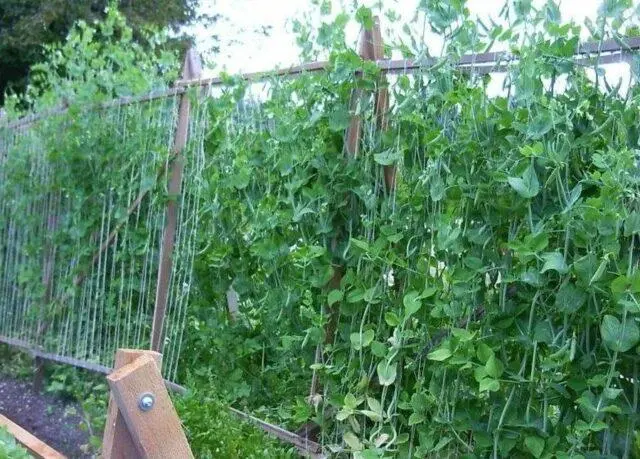
Peas planted along the fence not only receive support themselves, but also beautifully decorate the fence
Do-it-yourself support for peas
The construction of a support for a garter of peas in the open field usually does not cause any particular difficulties. The designs are very simple and require the use of inexpensive materials.
Support for peas from polypropylene pipes
You can make a support for garter peas from strong and durable polypropylene pipes left after home repairs. The algorithm looks like this:
- Choose several pipes of the same length and diameter with neat trimming.
- Install supports in the garden according to one of the schemes in the form of a wigwam, hut, trellis or other structure.
- Connect the poles to each other.
Polypropylene pipes are especially convenient in that they can not be tied, but fastened with inexpensive plastic fittings. The design will turn out to be very reliable and at the same time neat. With the use of pipes, it is really possible to build a support of any shape and complexity.
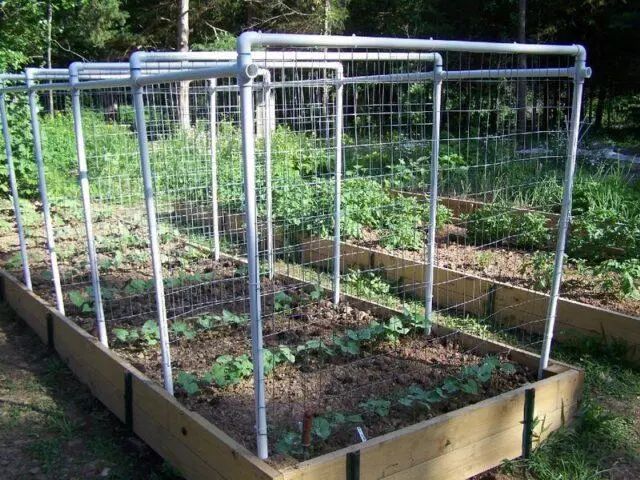
Polypropylene pipes are lightweight, so they need to be dug deeper into the ground so that the support does not fall
DIY portable trellis for peas
Peas are not recommended to be grown in the same place for more than a year. Therefore, it is convenient to build a light portable trellis for tying the culture, when the time comes, it can be rearranged to a new site. The support is made according to the following scheme:
- Four poles about 1,5-2 m long are connected in pairs at an angle with screws and horizontal rails at the base.
- The resulting triangular shapes are spread at different ends of the beds and fastened in the lower and upper parts with the help of long transverse beams.
- Twine or thick cords are tied to horizontal rails at intervals of about 20-30 cm.
Pea seeds are sown along the base of the trellis so that the sprouts rise close to the stretched pieces of twine. After the stems of the culture reach 30 cm or more, they are tied with a soft cloth.
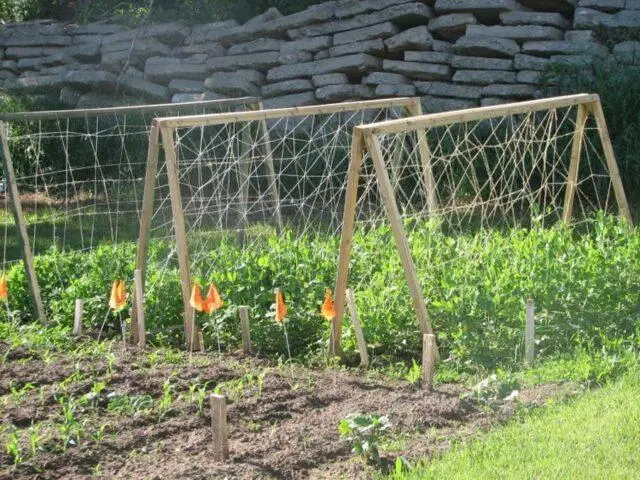
For long beds, you can make several compact trellises and place them next to each other
Support stakes
It is convenient to use stakes for garter in small beds, where the construction of a complex structure does not make sense. The supports are installed like this:
- Long stakes are dug into the ground at a distance of 20-30 cm from each other.
- Check that the supports are held firmly enough and will not fall to the ground under gusts of wind or when the soil is washed away during irrigation.
- Peas are sown in the garden, trying to place the seeds closer to the installed supports for the garter.
- As the shoots develop, they are fixed with soft ribbons on stakes every 20-30 cm.
Wooden garter poles are convenient because, if necessary, they can be installed on the beds even after pea germination.
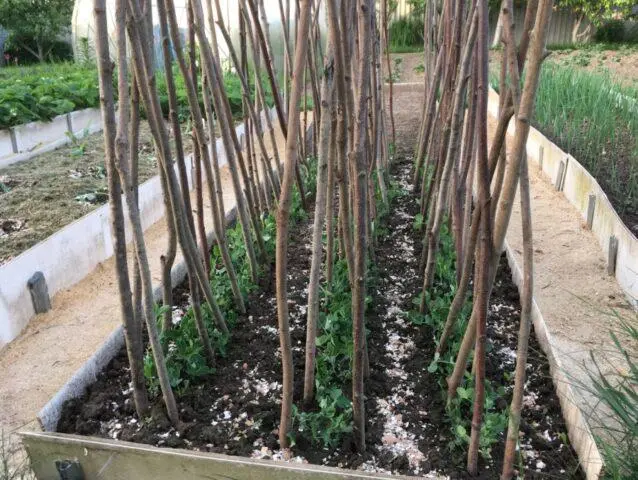
You can arrange the stakes on the bed with peas in rows, circles or in a checkerboard pattern as desired
Wigwam
The supporting structure of the “wigwam” looks very beautiful in the garden and performs not only practical, but also decorative functions. They do it like this:
- In the center of the beds, they dig in a wooden pole or a metal rod about 2 m high.
- At a distance of 70 cm from it, stakes are placed at equal intervals.
- The side parts of the “wigwam” are leaned against the central rod at an inclination of about 60 degrees.
- Fasten all the stakes together in the upper part with twine, wire or reinforcement.
It is better to sow peas in the garden after the construction of the “wigwam” in order to place the seeds clearly in a circle at the base of the structure.
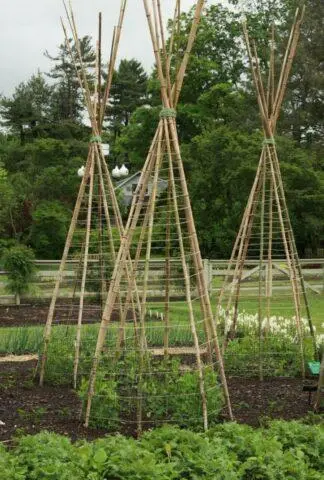
The inner diameter of the wigwam support should be about 1 m
Common mistakes
Setting up pea garter props is rarely a problem for gardeners. But there are a few common mistakes that can hinder culture development:
- The construction of the structure after planting peas. Some supports, for example, stakes, can be dug into the bed with sprouted shoots. But trellises, huts and wigwams must be installed before sowing seeds, otherwise there is a risk of damaging young bushes.
- Use of metal rods and profiles. Iron structures get very hot in the sun and can leave burns on pea shoots and leaves. You can use metal supports for the garter, but only to strengthen the trellis or wigwam. They should not come into direct contact with the plant.
- Unstable installation of the structure. Tapestries, huts and other supports must be properly fixed on the surface of the earth so that they do not fall even with a squally wind. It is recommended not only to put the structure on top of the beds, but to dig it securely into the ground.
When making a garter for pea stalks, you can not use hard cords, fabrics, and even more so wire. This leads to fractures of the shoots and slowing down the growth of the bushes.
Conclusion
You can tie peas in the garden to ordinary trellises or more complex designs. It is easy to build them in the garden, but attention must be paid to the strength of the supports and the quality of the fixation of the stems.









